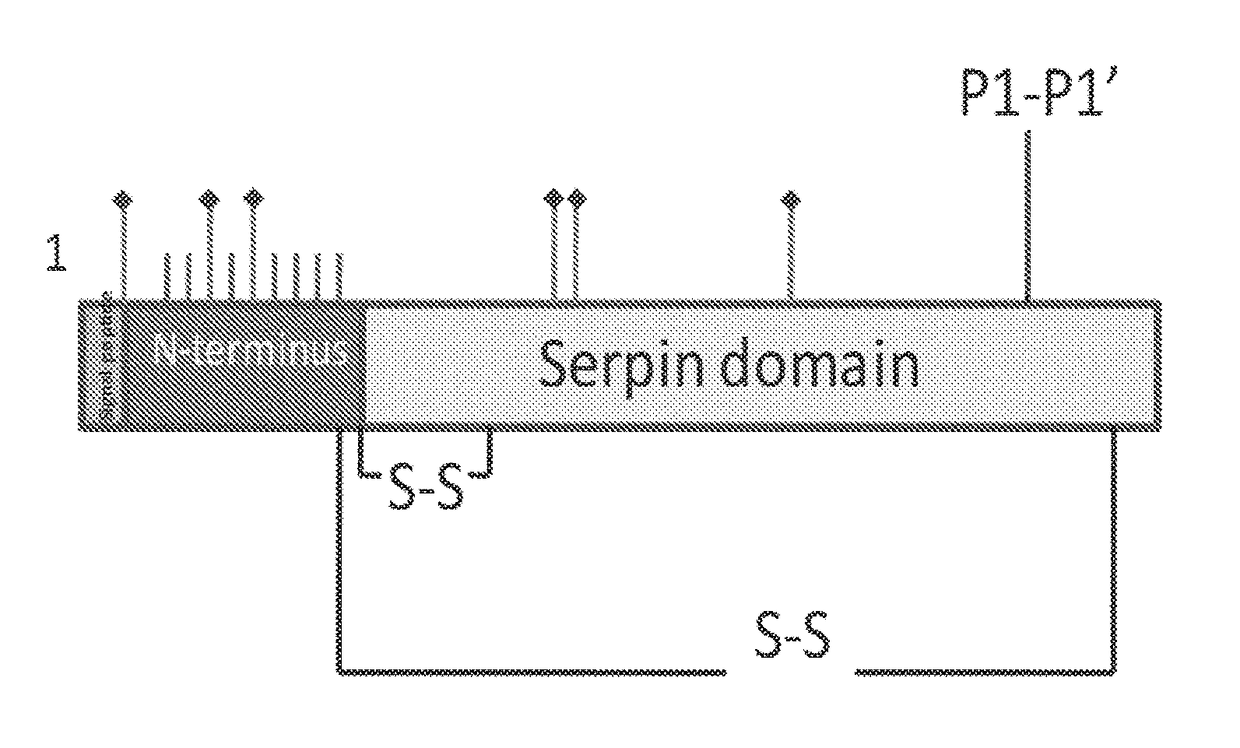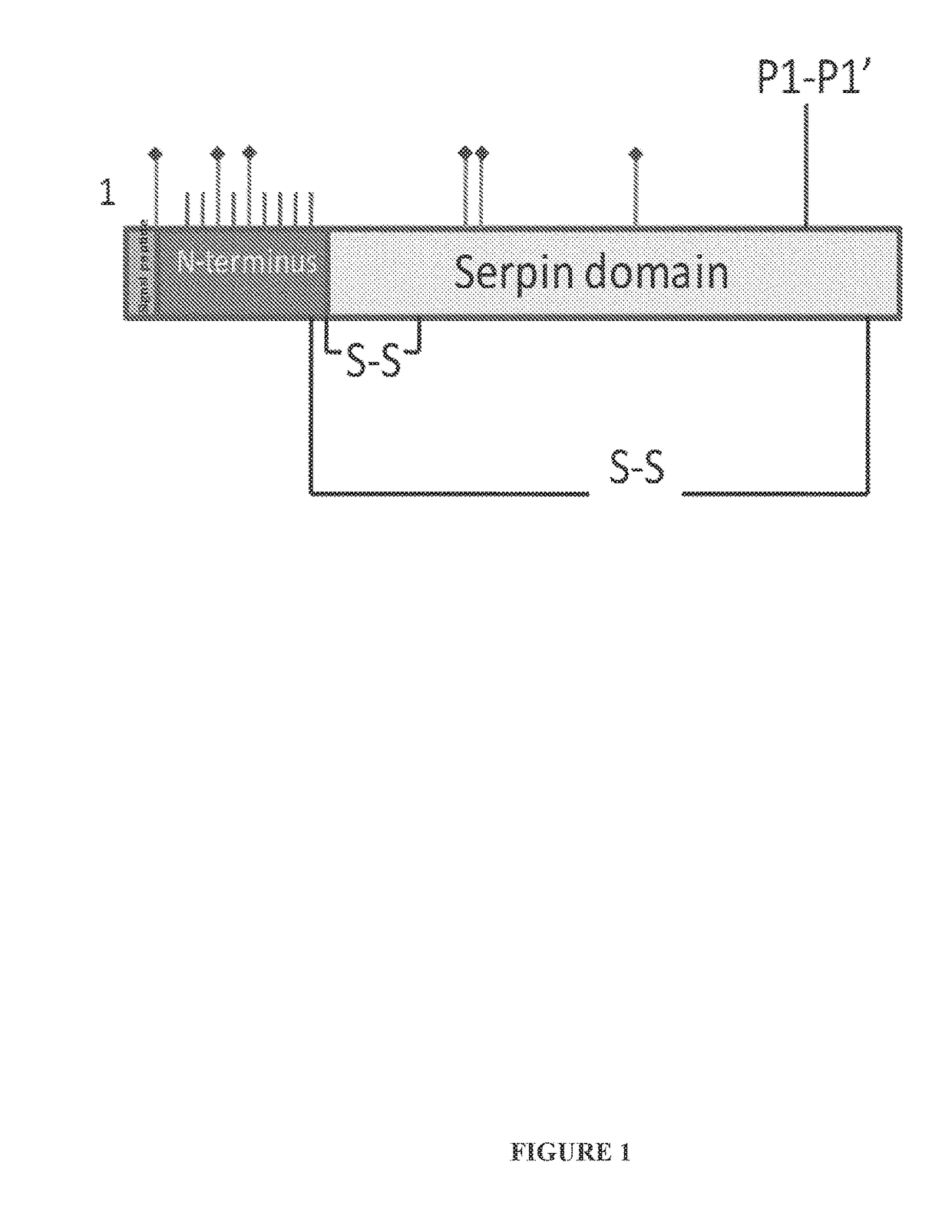Recombinant human c1 esterase inhibitor and uses thereof
a technology of esterase inhibitor and esterase, which is applied in the field of recombinant human c1 esterase inhibitor, can solve the problems of ruconest carries the risk of hypersensitivity and/or anaphylaxis reactions, and achieves the effects of safer, more effective treatment of hae, and cost-effective and reliable manufacturing
- Summary
- Abstract
- Description
- Claims
- Application Information
AI Technical Summary
Benefits of technology
Problems solved by technology
Method used
Image
Examples
example 1
Expression of Recombinant Human C1-INH
[0240]The amino acid sequence of human plasma derived C1-INH was used to create a CHO-optimized nucleotide sequence. This sequence was then inserted into a pXLG6 expression vector and transfected into CHO cells.
[0241]Two different methods of transfection (HD1 and HD2) and two different culture temperatures (31° C. and 37° C.) were tested. For both HD1 and HD2, on the day of transfection, the cells were passaged into fresh Growth Medium and a mixture of Polyethyleneimine Linear MW 25,000 (PEI) and DNA was added to the cells. All of the transfections showed good viability and good transfection efficiency. C1-INH activity and antigen ELISA assays were used to determine the titers of active protein in cell culture supernatant.
[0242]C1 inhibitor was expressed at high levels (>200 mg / L) for all conditions tested. The combination of HD2 and Feed unexpectedly resulted in very high expression levels (>600 mg / L). At 37° C., this condition can reach more t...
example 2
ment of Stable Clones Producing C1-Inhibitor
[0243]A CHO cell line adapted to suspension culture and serum free growth conditions was used as the parent cell line to generate and develop cell lines stably expressing recombinant human C1-INH.
[0244]The parental CHO cell line was transfected with pXLG6-C1-INH by chemical transfection using both HD1 and HD2. Recombinant cell pools were selected over several days with puromycin and tested for their rhC1-INH expression levels. Clonal populations were then generated by limiting dilutions of the pools. Pool Nos. 1 and 12 were chosen for use in producing clonal cell lines due to the combination of high expression level and high Activity / Antigen ratios.
[0245]Starting from Pool Nos. 1 and 12, single cell cloning was performed using a limiting dilution method in 96-well plates. Cell density, viability, and productivity were measured on a regular basis. Clone Nos. 1 and 31 were selected for further development based on high productivity, quality ...
example 3
ure Optimization
[0246]To identify a robust combination of clone / medium, e.g., high volumetric productivity and desired degree of sialylation, for the development of a scalable production process, a media screening study of 40 commercial media was performed using Clone Nos. 1 and 31.
[0247]Depending on the cultivation medium used, Clone No. 1 was able to produce about 1000-1200 mg / L of recombinant C1-INH, while Clone No. 31 produced about 600-800 mg / L. However, the sialylation of the C1-INH produced by Clone No. 31 appeared more similar to plasma-derived C1-INH than the C1-INH produced by Clone No. 1. Accordingly, Clone No. 31 was selected for further development.
PUM
| Property | Measurement | Unit |
|---|---|---|
| Temperature | aaaaa | aaaaa |
| Temperature | aaaaa | aaaaa |
| Temperature | aaaaa | aaaaa |
Abstract
Description
Claims
Application Information
 Login to View More
Login to View More - R&D
- Intellectual Property
- Life Sciences
- Materials
- Tech Scout
- Unparalleled Data Quality
- Higher Quality Content
- 60% Fewer Hallucinations
Browse by: Latest US Patents, China's latest patents, Technical Efficacy Thesaurus, Application Domain, Technology Topic, Popular Technical Reports.
© 2025 PatSnap. All rights reserved.Legal|Privacy policy|Modern Slavery Act Transparency Statement|Sitemap|About US| Contact US: help@patsnap.com



